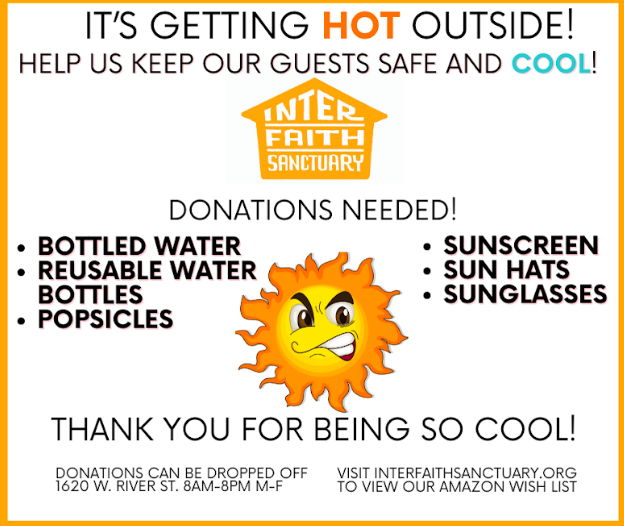
By: Christine Hahn, Abby Davids and Melissa Roop
Word on the Street Issue 45, July 2024
. . .
Editor’s Note: We are all three physicians who are working together on a project to reduce the impact of heat on the unhoused population
Being outside can be difficult when it’s cold, but as the temperatures start to heat up in the Treasure Valley, it’s time to start thinking about how we can stay safe when it’s hot outside. It has become apparent that spending a lot of time in the heat can be really hard on people’s bodies.
So, what can be done?
Boise experienced a hot summer in 2023. According to weather experts, the city experienced an average high temperature of 90.2 degrees last summer, with outdoor temperatures reaching 100 degrees or more. And predictions show that summers are only getting hotter.
For people who live downtown and spend much of their day outdoors, this could not only make for an uncomfortable summer, but one that could be very bad for their health.
While most people can adapt to slow increases in average normal temperatures, those that find it harder to adjust to increasing heat include children, pregnant women and older adults. These groups are at higher risk of heat-related illness because they are less able to regulate their body temperatures.
Other at-risk groups include people who work outdoors, outdoor athletes, the socially isolated, unhoused populations and communities of color.
It’s not just about heat stroke—anyone with who has chronic conditions such as cardiovascular disease, respiratory disease, cerebrovascular disease and diabetes-related conditions could find that their conditions worsen in the heat. This can include difficulty breathing, increased coughing, feeling more tired than usual or swelling in the feet and legs.
Longer exposure to high temperatures is linked to increased hospital admissions for many chronic diseases.
Changes in the design of outdoor spaces may help, but there are also some things you can do to protect yourself.
Changes to outdoor spaces include adding more shade to the downtown area, either by trees, sunshades, or other structures; increasing availability of cooling shelters; or increasing access to other indoor, air-conditioned places during the day.
In addition, here are some personal actions you can take:
– Wear loose, lightweight, light-colored clothing
– Find shade
– Wear a hat wide enough to protect your face
– Drink plenty of fluids to stay hydrated
– Go to a cooling center. Locations of cooling shelters may be listed at sites such as https://www.ourpathhome.org/
– Seek sources of safe cooling water—such as areas with misters or public spaces with natural water flow
– Avoid high-energy activities or work outdoors, during midday heat, if possible
– Check on others to be sure they are OK
– Consider pet safety. If they are outside, make sure they have plenty of cool water and access to comfortable shade. Asphalt and dark pavement can be very hot to your pet’s feet
– Never leave people or pets in a closed car on a warm day
– Know the signs of heat cramps, heat exhaustion, and heat stroke:
– Signs of heat cramps: muscle pains or spasms in the stomach, arms or legs
– Signs of heat exhaustion: Heavy sweating, paleness, muscle cramps, tiredness, weakness, fast or weak pulse, dizziness, headache, fainting, nausea, vomiting
– If you or a friend have signs of heat cramps or heat exhaustion, go to a cooler location and cool down by removing excess clothing and taking sips of sports drinks or water. Call your healthcare provider if symptoms get worse or last more than an hour
Signs of heat stroke:
– extremely high body temperature
– red, hot and dry skin with no sweat
– rapid, strong pulse
– dizziness, confusion or unconsciousness
If heat stroke is suspected, call 911 or get the affected person to a hospital immediately
References:
Goodwin, S. (2023, September 8). By 2100 Boise will have a climate like the desert Southwest . Idaho Statesman. https://www.idahostatesman.com/news/weather-news/article278796689.html
Ready.gov. (2023, June 9). Extreme heat. Extreme Heat . https://www.ready.gov/heat#:~:text=If%20you%27re%20outside%2C%20find,during%20midday%20heat%2C%20if%20possible
Sarofim, M. C., Saha, S., Hawkins, M. D., Mills., D. M., Hess, J., Horton, R., Kinney, P., Schwartz, J., & Juliana, A. St. (2016b, April 4). Ch. 2: Temperature-related death and illness. The Impacts of Climate Change on Human Health in the United States: A Scientific Assessment. https://health2016.globalchange.gov/temperature-related-death-and-illness#figure-195
